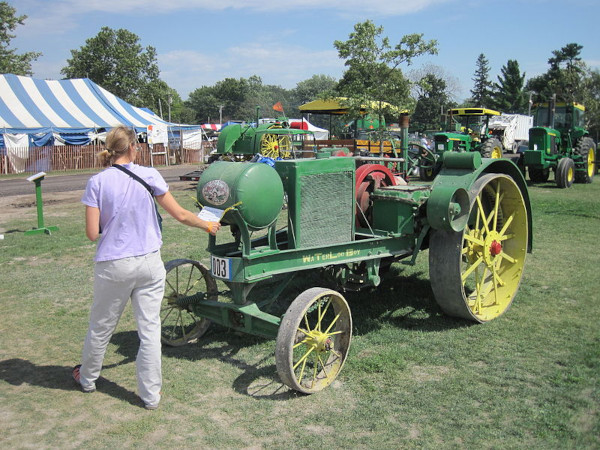Complete John Deere History Timeline - 1837 to Today
Sept. 5, 2021
John Deere is among the world's most recognized iconic brands. Since its founding over 180 years ago, Deere & Co. has contributed greatly to improving global well-being by manufacturing innovative agriculture and construction equipment.

The Life of John Deere & A Tradition of Innovation
John Deere, born in 1804 in Rutland, Vermont, was a blacksmith who founded what would eventually become Deere & Company in 1837. John Deere began his blacksmith apprenticeship in 1821 at the age of 17, and he entered the trade in 1826. He married Demarius Lamb in 1827 and together, they had nine children.
John Deere moved from Vermont to Illinois in 1836 because of an economic downturn in Vermont, and he realized the demand for blacksmithing was higher in Illinois.
John Deere's initial blacksmith shop in Grand Detour, Illinois, was a humble 1,378 square feet. The shop manufactured a variety of common items blacksmiths made during that time including, shovels, pitchforks, and (of course) John Deere's innovative self-scouring steel plow.
Demand for John Deere's self-scouring steel plow rapidly grew because it was innovative and enabled farmers to work their fields more efficiently. Other contemporary plows were made out of cast iron or wood, and they performed poorly in the often soggy Midwestern fields. John Deere realized that using smooth steel from a Scottish steel saw blade was much more efficient and did not get stuck in the mud as easily.

Early John Deere steel plow circa 1845 on display in Henry Ford Museum
Source: Wikipedia.
As demand for John Deere's plow grew, he moved his shop to Moline, Illinois (same metro area as the Company's present-day headquarters) along the east bank of the Mississippi River. Rivers and waterways were critical for industries during the 19th century because we did not yet have trucks and highways - water transportation was the cheapest and most efficient mode of moving goods and raw materials. The new riverside location enabled John Deere to procure raw materials and parts faster and cheaper, as well as ship his finished goods to customers far away.
John Deere's plow was instrumental in enabling the western migration of settlers during the 1800s. The plow enabled farmers to do more with less, which improved farming efficiency and production. By 1855, Deere's factory had sold more than 10,000 plows, and it became known as "The Plow that Broke the Plains."
John Deere was a thoughtful man with foresight, drive, and strong ethics. He insisted on making high-quality equipment, and he often chose to take the higher path during business dealings. He once said, "I will never put my name on a product that does not have in it the best that is in me."
Similar to how Henry Ford is credited with inventing the modern-day production line, John Deere realized that stockpiling strategic inventory would help improve his sales. During John Deere's time, it was common for blacksmiths to operate "made-to-order" businesses, where they waited for an order before manufacturing an item. This process was slow and inefficient. John Deere chose to increase his manufacturing rate and stockpile strategic inventory of his products so customers could take delivery of their items when they placed orders.
In 1868 John Deere incorporated Deere & Company, and in 1876 he registered the first trademark. John Deere and his friend, Melvin Gould, designed the first logo that featured a deer bounding over a log. Over time the logo has changed moderately, but it has always kept the prominent deer and name John Deere.
Later in his life, John Deere focused his attention on serving as a community leader. In 1873 he became the second mayor of Moline, Illinois. He also served as President of the National Bank of Moline, a director of the Moline Free Public Library, and was a trustee of the First Congregational Church.
John Deere died at home in 1886 at the age of 82. He is buried at the Riverside Cemetery located in Moline, Illinois. His grave marker can be found at Lot 838-840, Grave # 11. His grave headstone bears the words "Our Father" on its top.

Source: Wikipedia.
Evolution of Deere & Company
Deere & Company provided basic blacksmith products and services when it first began. As John Deere's plow became famous and sales accelerated, the Company expanded its line of agricultural implements (fun fact: Deere & Company also manufactured other non-related items, including bicycles, during the late 1890s).
Waterloo Gasoline Engine Company
Deere & Company began designing tractors in 1912 under the helm of William Buttersworth (Charles Deere's son-in-law). The Company's entry into the tractor market became more pronounced when it purchased the Waterloo Gasoline Engine Company in 1918, which manufactured the popular Waterloo Boy tractor. Deere & Company continued to sell tractors under the Waterloo Boy name until 1923, when the John Deere Model D was introduced. Today the Company continues to manufacture many of its high horsepower tractors (7R, 8R, and 9R Series Tractors) in Waterloo.

Waterloo Gasoline Engine Company 1917 kerosene-fueled "Waterloo Boy" tractor.
Source: Wikipedia.
Wartime Production
During World War II, Deere & Company's President Charles Deere Wiman directed the farm machinery and equipment division of the War Production Board - an organization that helped the US government produce critical goods and machinery for the Allies' war effort. Deere & Company expanded its manufacturing capability during World War II to include military tractors, transmissions for the M3 tank, aircraft parts, ammunition, and mobile laundry units.
Construction & Forestry Equipment
In 1956 Deere & Company formed its Industrial Equipment Division (now the Construction & Forestry division) to focus on developing its construction equipment separate from its agriculture equipment. Deere & Company's Construction business has grown to be one of the world's largest through organic growth and acquisitions.
Evolution of the John Deere Logo & Branding
The John Deere logo has featured the well-recognized leaping deer since its origin in 1876. Although the logo has changed moderately over the decades, it has always remained fairly stable and identifiable. Any person today can look at the historical logos and immediately recognize it as the John Deere brand.
In 2000 Deere & Company updated the branding to the current logo. Most notably, the position of the deer changed to leaping upward - all prior logos featured the deer oriented downward. "The dawn of a new millennium marked by unusual technological innovation was precisely a point in time when the next step in the evolution of our logo was called for," said outgoing Deere & Company chairman Hans Becherer. "The more modern deer symbolizes strength, energy, movement, and progressiveness."

Source: Deere.com. All logos above are trademarks of Deere & Company.
Timeline collage above is for informational purposes only.
Best-Selling Tractor In USA
John Deere is the best-selling tractor in the United States. Although exact market share statistics are not available, it is estimated John Deere has about 65% of the high-horsepower tractor market.
Deere & Company Ownership Today
Deere & Company is a publicly-traded company on the New York Stock Exchange under the stock ticker "DE." Deere & Company is among the largest machinery stocks in the world, with a market capitalization of $108 billion as of September 2021.
The largest shareholders in Deere & Company are institutional investors. Bill Gate's investment Company, Cascade Investment, owns 10% of Deere & Company. Cascade Investment's Alan C. Heuberger sits on Deere & Company's Board of Directors.
The Deere family no longer owns a controlling stake in Deere & Company. Five generations of the Deere family have participated in the Company's leadership roles since its founding. Today, the CEO and Board of Directors are not related to the Deere family.
How John Deere Has Helped Improve The World
Farming is a critical industry since we all need to eat. Farming productivity has a direct impact on the economic well-being of all countries - economies can only produce cars, airplanes, mobile phones, etc if the population is fed and healthy. The other industries collapse quickly without an adequate food supply.
About 200 years ago, over 90% of the population worked on farms, and today it is less than 3%. This dramatic reduction in this percentage has led to an economic productivity boom - displaced farmworkers can expand into new fields and create new products that would not have been possible before. The work output from a single farmer driving a high-horsepower John Deere 9R Series Tractor is greater than dozens of farmers without modern machinery.
John Deere's innovation over the years has led to better farm equipment, which directly improves the overall well-being of the global economy. It is estimated that during the past 20 years, over one billion people have been lifted out of poverty. Farming productivity improvements have been a major contributor to this trend. With this logic, John Deere has played an instrumental role in reducing global poverty.

Source: USDA.gov
Takeaway: Farm productivity increases every year driven by better equipment and technology

Source: USDA.gov
Takeaway: Over time, the average farm size has grown because farmers can manage larger fields by using better farm equipment
Looking Forward
Deere & Company continues to innovate and invest in research and development - through cycle ups and downs, the Company has stayed committed to its future plans. More recently, Deere & Company has placed an increased focus on electrification and autonomous technologies.
Deere & Company is also focused on acquiring various agriculture-focused technology startups. In 2017 it purchased Blue River Technology for $305m.
Innovation is ingrained in John Deere's history, brand and workforce. It seems to be a safe bet to assume Deere & Company will continue to innovate and deliver innovative and reliable farm and construction equipment.
Sources
Deere & Company website
Wikipedia history of Deere & Company
Wikipedia history of John Deere
Henry Ford Museum
Fandom Tractor & Construction Plant
Resources
Find John Deere Dealers
John Deere - 175 Years



